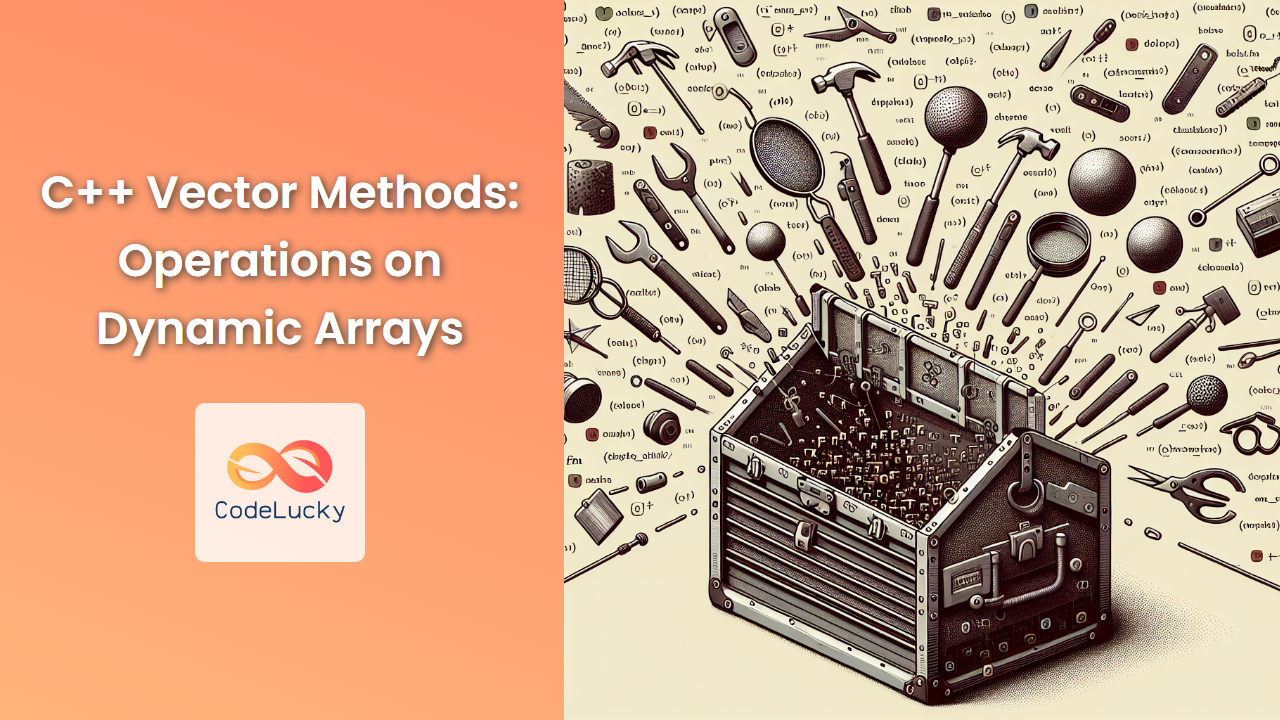In the world of C++ programming, vectors are a powerful and flexible container that allows for dynamic array management. They provide an array-like structure that can grow or shrink in size automatically, making them an essential tool for many programming tasks. In this comprehensive guide, we'll explore the various methods and operations you can perform on C++ vectors, complete with practical examples and in-depth explanations.
Introduction to C++ Vectors
Vectors in C++ are sequence containers representing arrays that can change in size. Unlike traditional arrays, vectors use contiguous storage locations for their elements, which means that their elements can be accessed just as efficiently as those in arrays, but with added flexibility of being able to change size dynamically.
To use vectors in your C++ program, you need to include the vector header:
#include <vector>
Let's start by creating a simple vector:
std::vector<int> myVector = {1, 2, 3, 4, 5};
This creates a vector of integers initialized with the values 1 through 5.
Basic Vector Operations
1. Adding Elements
🔹 push_back(): Adds an element to the end of the vector.
myVector.push_back(6);
// myVector now contains: 1, 2, 3, 4, 5, 6
🔹 emplace_back(): Constructs an element in-place at the end of the vector.
myVector.emplace_back(7);
// myVector now contains: 1, 2, 3, 4, 5, 6, 7
The difference between push_back() and emplace_back() is that emplace_back() constructs the element directly in the vector, which can be more efficient for complex objects.
2. Accessing Elements
🔹 operator[]: Accesses an element at a specific index.
int thirdElement = myVector[2];
// thirdElement is 3
🔹 at(): Accesses an element with bounds checking.
int fourthElement = myVector.at(3);
// fourthElement is 4
The at() method is safer than operator[] because it throws an out_of_range exception if the index is out of bounds.
3. Removing Elements
🔹 pop_back(): Removes the last element.
myVector.pop_back();
// myVector now contains: 1, 2, 3, 4, 5, 6
🔹 erase(): Removes element(s) at a specific position or range.
myVector.erase(myVector.begin() + 2);
// myVector now contains: 1, 2, 4, 5, 6
4. Size and Capacity
🔹 size(): Returns the number of elements.
🔹 capacity(): Returns the current capacity of the vector.
🔹 resize(): Changes the size of the vector.
std::cout << "Size: " << myVector.size() << std::endl;
std::cout << "Capacity: " << myVector.capacity() << std::endl;
myVector.resize(10);
// myVector now contains: 1, 2, 4, 5, 6, 0, 0, 0, 0, 0
Advanced Vector Operations
1. Iterating Through a Vector
C++ vectors support various ways of iteration. Let's explore them:
🔹 Range-based for loop:
for (const auto& element : myVector) {
std::cout << element << " ";
}
// Output: 1 2 4 5 6 0 0 0 0 0
🔹 Iterator-based loop:
for (auto it = myVector.begin(); it != myVector.end(); ++it) {
std::cout << *it << " ";
}
// Output: 1 2 4 5 6 0 0 0 0 0
2. Sorting a Vector
The C++ Standard Library provides powerful algorithms for sorting vectors:
#include <algorithm>
std::vector<int> unsortedVector = {5, 2, 8, 1, 9};
std::sort(unsortedVector.begin(), unsortedVector.end());
// unsortedVector now contains: 1, 2, 5, 8, 9
3. Finding Elements in a Vector
The find algorithm can be used to search for elements:
auto it = std::find(myVector.begin(), myVector.end(), 5);
if (it != myVector.end()) {
std::cout << "Found 5 at position: " << std::distance(myVector.begin(), it) << std::endl;
} else {
std::cout << "5 not found in the vector" << std::endl;
}
4. Vector of Custom Objects
Vectors can store custom objects. Let's create a Person class and a vector of Person objects:
class Person {
public:
Person(std::string name, int age) : name(name), age(age) {}
std::string name;
int age;
};
std::vector<Person> people;
people.emplace_back("Alice", 30);
people.emplace_back("Bob", 25);
people.emplace_back("Charlie", 35);
// Sorting the vector of Person objects by age
std::sort(people.begin(), people.end(), [](const Person& a, const Person& b) {
return a.age < b.age;
});
// Print sorted vector
for (const auto& person : people) {
std::cout << person.name << ": " << person.age << std::endl;
}
Output:
Bob: 25
Alice: 30
Charlie: 35
Performance Considerations
When working with vectors, it's important to understand some performance implications:
- Reserve: If you know the size of your vector in advance, use
reserve()to allocate memory upfront and avoid multiple reallocations:
std::vector<int> efficientVector;
efficientVector.reserve(1000);
for (int i = 0; i < 1000; ++i) {
efficientVector.push_back(i);
}
- Emplace vs. Push: For complex objects,
emplace_back()can be more efficient thanpush_back()as it constructs the object in-place:
std::vector<std::pair<int, std::string>> pairVector;
pairVector.emplace_back(1, "one"); // More efficient
pairVector.push_back(std::make_pair(2, "two")); // Less efficient
- Erasing Elements: Erasing elements from the middle of a vector can be costly as it requires shifting all subsequent elements. If order doesn't matter, consider swapping with the last element and then popping:
void quickRemove(std::vector<int>& v, std::vector<int>::iterator it) {
*it = std::move(v.back());
v.pop_back();
}
Practical Example: Word Frequency Counter
Let's put our vector knowledge to use with a practical example. We'll create a program that counts the frequency of words in a given text:
#include <iostream>
#include <vector>
#include <string>
#include <algorithm>
#include <sstream>
struct WordFreq {
std::string word;
int frequency;
WordFreq(const std::string& w) : word(w), frequency(1) {}
};
int main() {
std::string text = "the quick brown fox jumps over the lazy dog";
std::vector<WordFreq> wordFreqs;
std::istringstream iss(text);
std::string word;
while (iss >> word) {
auto it = std::find_if(wordFreqs.begin(), wordFreqs.end(),
[&word](const WordFreq& wf) { return wf.word == word; });
if (it != wordFreqs.end()) {
it->frequency++;
} else {
wordFreqs.emplace_back(word);
}
}
// Sort by frequency
std::sort(wordFreqs.begin(), wordFreqs.end(),
[](const WordFreq& a, const WordFreq& b) { return a.frequency > b.frequency; });
// Print results
std::cout << "Word Frequencies:" << std::endl;
for (const auto& wf : wordFreqs) {
std::cout << wf.word << ": " << wf.frequency << std::endl;
}
return 0;
}
Output:
Word Frequencies:
the: 2
quick: 1
brown: 1
fox: 1
jumps: 1
over: 1
lazy: 1
dog: 1
This example demonstrates several vector operations:
- Creating a vector of custom objects (
WordFreq) - Using
emplace_back()to add elements efficiently - Searching the vector with
find_if() - Sorting the vector with a custom comparator
- Iterating through the vector to display results
Conclusion
C++ vectors are versatile and powerful containers that offer dynamic size management and efficient element access. We've explored various methods for adding, removing, and accessing elements, as well as more advanced operations like sorting and searching. By mastering these vector operations, you'll be well-equipped to handle a wide range of programming challenges efficiently.
Remember, while vectors are generally very efficient, it's important to choose the right container for your specific needs. For scenarios requiring frequent insertions or deletions at the beginning or middle of the sequence, you might want to consider other container types like std::list or std::deque.
As you continue to work with C++ vectors, you'll discover even more ways to leverage their power in your programs. Happy coding! 🚀
















